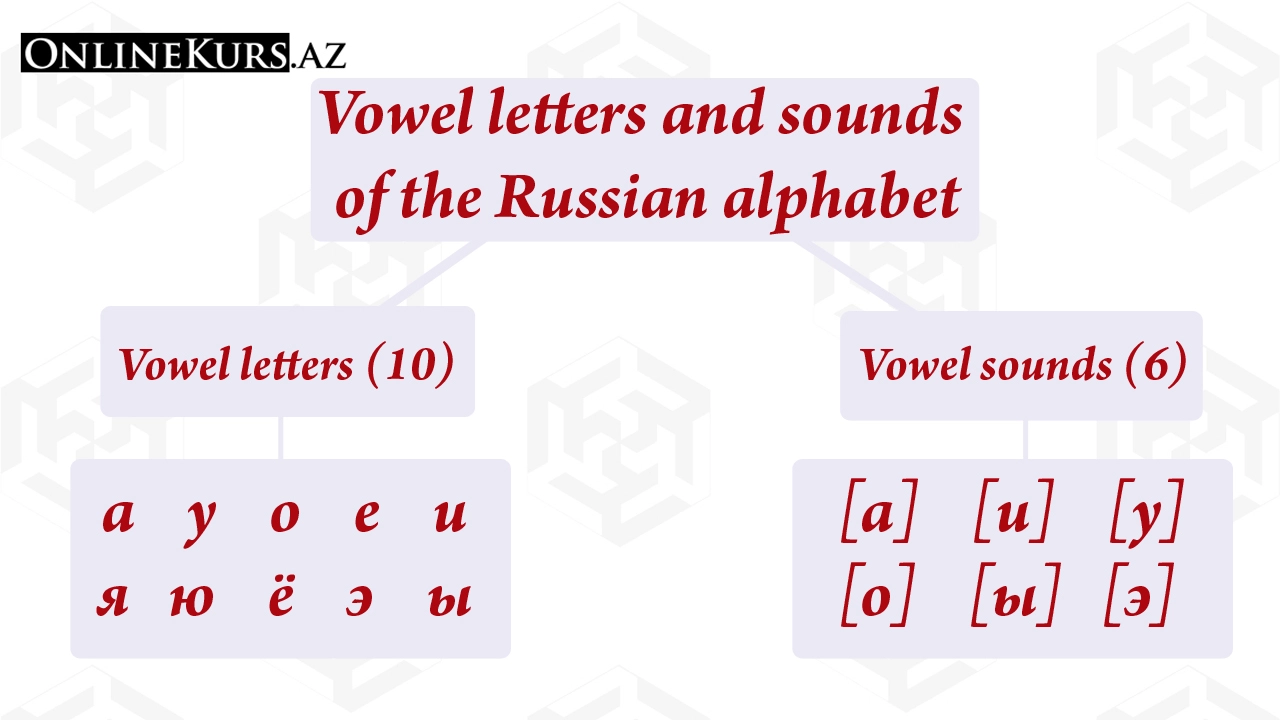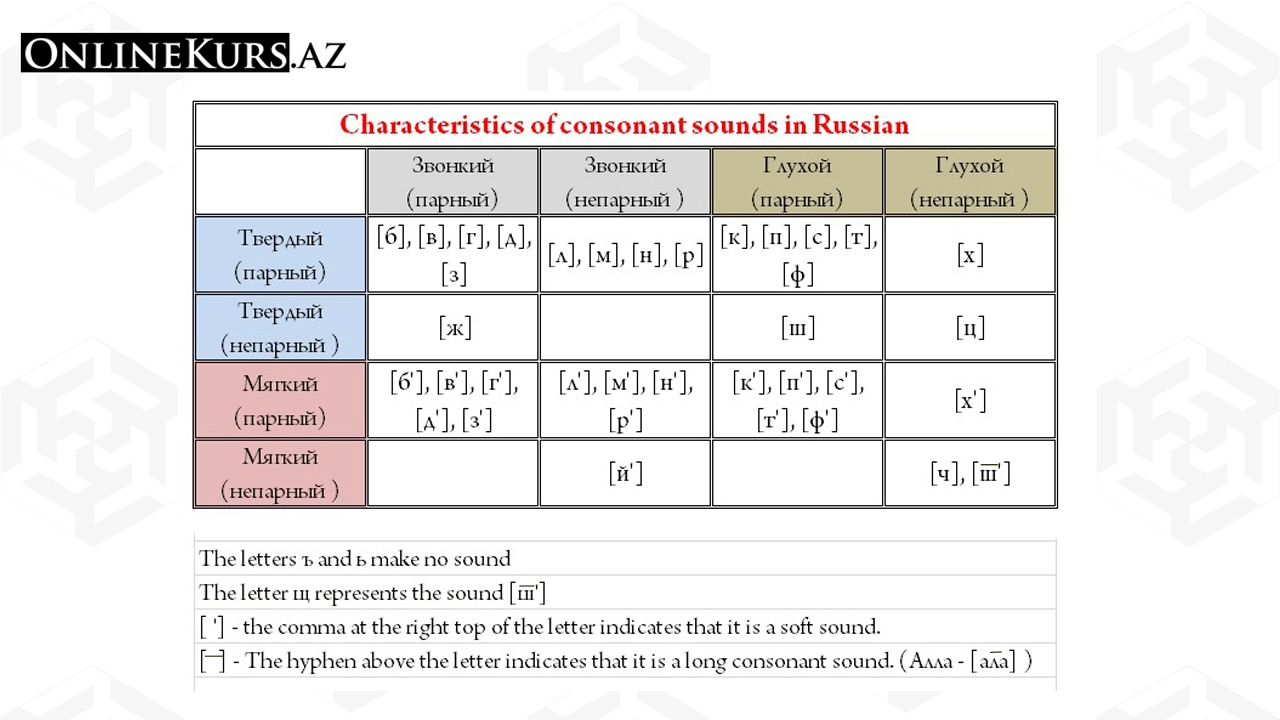Russian phonetics
In this lesson we will learn Russian phonetics. Vowels and consonants of Russian alphabet.
We are starting the next lesson in Russian. In this lesson, we will talk about the phonetics of the Russian language. Phonetics is the one of the main branches of linguistics. Speech sounds are studied in phonetics. The sounds we pronounce when we speak are called speech sounds. The lips, tongue and vocal cords are involved in the formation of speech sounds. We pronounce and hear the sounds of speech. In the text, they are indicated by letters. We see and write the letters. To distinguish sounds from letters, they are enclosed in parentheses in transcripts.
As we know, speech sounds are divided into 2 types according to their different characteristics: vowels and consonants. In Russian, vowels are called "гласные звуки", and consonant sounds in Russian are called "согласные звуки". As we said in the previous lesson, there are 33 letters in the Russian alphabet. 10 of them are vowels, 21 are consonants, and 2 letters - "ъ" and "ь" are not pronounced. Vowels are pronounced freely and unobstructed in the oral cavity. Therefore, they sounds clear. Another feature of vowels is the formation of syllables. But in pronunciation of consonants it forms various obstacles in the oral cavity. Although the Russian language consists of 33 letters, there are 42 sounds, of which 6 are vowels and 36 are consonants. The number of vowels and consonants in Russian does not match also, so there are only 6 vowel sounds in Russian, while there are 10 vowel letters. The same inconsistency is also observed in consonants - there are 21 consonant letters, but there are 36 consonant sounds in Russian alphabet. This quantitative difference is explained by a number of features of Russian language. Let's explore these features.
Russian vowels
At first, let's start from Russian vowels. Vowels consist only of sounds. Consonant sounds, in addition to sound, must also consist of noise, or only noise. So, if there is no noise in the sound, then it is a vowel sound. As we said, in Russian there are 10 vowel letters, but there are only 6 vowel sounds. The reason for this is that in Russian, 6 vowel sounds are marked with 10 vowel letters in writing. This is one of the features of the Russian language, and that is why in the Russian language there are only 6 vowel sounds, while there are 10 vowel letters.

Now let's see these features of Russian vowels in examples: [ и ] - "и" - (милый) [ ы ] - "ы" - (мыло) [ а ] - "а" - (май) and "я" - (моя). As you can see, the word "моя" is written here with 3 letters, but in the transcription it is marked with 4 sounds - [мо́й'а], and if we pronounce this word, we will see that 4 sounds are really used here. The letter "я" was pronounced with 2 sounds - [ й ] and [ а ]. However, this does not mean that all words written with the letter "я" in Russian must be pronounced with 2 sounds. No, this is not the case, for example, the word "Сяду" is written with the letter "я", but it is not pronounced with 2 sounds, but only with the sound [ а ]. This is due to the orthographic and orthoepic features of the Russian language, which we will discuss in our next lessons related to the Russian phonetics section and when going through the Russian orthography, we will learn the regularities of these features. Now just note that the sound [ а ] is written in 2 letters, either with the letter [ а ] or with the letter "я". The same rule will be followed in the next letters: [ о ] - "о" - (мой) and "ё" - (ёлка) [ э ] - "э" - (это) and "е" - (мeл) [ у ] - "у" - (куст) and "ю" - (юла).
So, everything is clear with the first 2 sounds - [ и ] and [ ы ]. Each of them has its own corresponding single letter in the writing. This issue is clear. There are 2 types of letters for the other 4 vowel sounds - [ а ], [ о ], [ э ], [ у ] in the text: 1. "а", "о", "э", "у"; 2. "я", "ё", "е", "ю".
The first type of letters is clear, each of them is marked with its own corresponding letter in the text. So we put them aside. We are interested in the second type of letters - "я", "ё", "е", "ю". They are not sounds, they are letters. Don't forget that. Therefore, they are not mentioned in the transcription. Rather, they are pronounced as "а", "о", "э", "у", or are pronounced with 2 sounds as in the word [мо́й'а]. This is only the case with accented syllables. Remember that only in accented syllables the letters "я", "ё", "е", "ю" are pronounced as "а", "о", "э", "у" - with 1 sound. From this point of view, the letters "я", "ё", "е", "ю" have two functions: 1. These letters indicate that the consonant sound that precedes it is a soft consonant sound. In Russian, consonants are soft and hard consonants due to their characteristics. In this lesson, we will also speak about the Russian consonant sounds and talk about it in detail, now just conditionally note that the letters "я", "ё", "е", "ю" precede the consonant sound as a soft consonant sound. For example: "Сяду" - [ с’а́ду ], "сел" - [ с’э́л ], "сёл" - [ с’о́л ], "сюда" - [ с’уда́ ]. If you pay attention, in pronunciation these words, the letter "С" is pronounced softly. At the same time, the emphasis in these words falls on the first syllable.
2. The other function of these letters is that they are pronounced as 2 sounds after vowels, at the beginning of a word, or after the letters "ъ" and "ь" - a consonant sound [ й ] adds, as in the example of "моя" - [ мо́й'а ]. The letters "ъ" and "ь" are also called separators. We will talk about this in more detail in our next lesson. Thus, in these 3 cases, they are pronounced as 2 sounds. Let's take a look at the examples for each of the three situations: After the vowels: "жуёт" - [жуйо́т], "бреют" - [бр’э́йут]; At the beginning of the word: "ел" - [йэ́л], "якорь" - [й'а́кар']; After the letters "ъ" and "ь": "съел" - [сйэ́л], "вьюн" - [в’йу́н]. This is one of the features of the Russian language, and that is why the Russian alphabet there are only 6 vowel letters, while the vowel sounds are 10.
Russian consonant sounds
Now let's talk about the Russian consonant sounds. Consonant sounds are divided into 2 parts according to the presence of vocal cords - voiceless consonants and voiced consonants. If the vocal cords are present, these are voiced consonants, and if they are not present, then they are voiceless consonants. Voiceless consonants are called "глухие согласные" in Russian, and voiced consonants are called "звонкие согласные". Voiced consonants - [б], [в], [г], [д], [ж], [з], [й], [л], [м], [н], [р]. Voiceless consonants - [к], [п], [с], [т], [ф], [х], [ц], [ч], [ш], [щ].
At the same time, consonant sounds are paired according to voiceless and voiced, and in this regard are divided into two parts: those that form a pair – and called "парные" in Russian and those that do not form a pair called – "непарные". You can see the Russian consonant sounds in pairs more clearly in the table below. If you learn this table, you will remember the characteristics of Russian consonant sounds. In the table, the distribution of all Russian consonant sounds is very nicely marked according to their voiced and voiceless, hardness and softness, and their pairs at the same time. I don't want to talk about it much, but if you want to learn more about this, this chart will help you. If you have to do phonetic analysis, then you need to know these divisions perfectly.

At the same time, consonant letters are divided into soft and hard consonants according to the form take the tongue in pronunciation in the oral cavity. If the middle part of the tongue rises upwards during pronunciation, then this consonant sound is a soft sound. Hard consonants are called "твердые согласные" in Russian. Soft consonants are called "мягкие согласные". Consonants are paired due hardness and softness also.
If you notice, soft consonant sounds are marked with a comma in the upper right part of the letter in the transcription. This comma is used to indicate that the consonant sound is soft.
If you remember, when we talked about vowels, we noted that the letters "я", "ё", "е", "ю" meant that the consonant sound that preceded is a soft consonant sound. There is one exception. Thus, these letters after the consonants "ж" and "ш" do not indicate the soft pronunciation of the consonants "ж" and "ш". So, as you can see from the table, in modern Russian these sounds are hard consonant sounds.
So, we conclude this lesson here. Thank you and see you in our next lessons.
We believe that the education should be free and available to everybody. This is why some time ago, we made a decision to continue developing as a completely free network. But we need the support of our readers to continue creating new content, keep the development going and pay related expenses. If you like what we do and find it helpful, consider supporting us by making a donation to our accounts.